Sunday, 10 May 2009
Reason for late post
Saturday, 9 May 2009
Mulki Mohamed Evaluation
With the name of our film is “Till Death Do Us Part.” We attempted to use conventions of0 thrillers, as this was the genre we were working in. Several thriller movie titles suggest what could possibly happen within the actual narrative. Some examples of that is the thriller “The Secret Window" starring Johnny Depp , ‘The Uninvited’ starring Emily Browning and “The Descent” starring Shauna MacDonald. In our opening sequence I suggested we go for a symbolic and ambiguous opening. Here we developed our film by incorporating different techniques such as fades, black and white effects, and manipula
, ‘The Uninvited’ starring Emily Browning and “The Descent” starring Shauna MacDonald. In our opening sequence I suggested we go for a symbolic and ambiguous opening. Here we developed our film by incorporating different techniques such as fades, black and white effects, and manipula
ting the camera angles to create a reminiscent effect. We followed many of the thriller conventions for our film, some examples of the ones we used efficiently is a point of view shot, we used the thriller ‘Rear Window’ by Alfred Hitchcock for inspiration, and we had applied that technique to our own thriller opening. I thought we were successful in that part in addition of the melancholic piano soundtrack in which we developed because we mixed two different pieces together.
The conventions of a thriller we used were non diagetic sounds which was the eerie of the piano creating a spine-chilling effect. We got that idea from certain thriller openings such as “The Secret Window” where the beginning creates an uncanny sound, which was a mixture of dialogue and diagetic sound. We have changed that convention and decided to have Music running throughout the opening sequence. We wanted to make the audience uncomfortable, also on the edge.
2.) How does your media product represent particular social groups?
In our thriller opening the social groups are clearly portrayed as we are seeing two characters that are both adults. Our characters have jobs, from the scenes where (Karen Smith) is in an office, this would convey the Adult social group. Our thriller opening represents a particular social group because the aren’t any other social groups in our opening.
3.) What kind of media institution might distribute your media product and why?
I have chosen Lionsgate to distribute my media product my reasons for this is as this company has distributed countless thriller movies, this shows that the audience will be able to recognise my film as a thriller immediately. A Few of the films Lionsgate have distributed include ‘Cabin Fever’ (2003), ‘Saw’ (2004) ‘Hostel’ (2005) these movies represents Lionsgate’s successful thrillers. This is why I believe it would be fantastic for Lionsgate to Distribute my films. Lionsgate is an i
ndependent filmed entertainment studio, the company distributes films that are independent but also movies that are mainstream like the worldwide
movie “Crash” that won a few Oscars, and this conveys the company having a good reputation and success, predicting the success of our movie ‘Till Death Do Us Part’.
4.) Who would be the audience for your media product?
The audience for my media product would be roughly around twenty to thirty something year olds, but at the youngest 18+. We as a group conducted an audience research to decided what age our film will be targeted at. From our research we have given our questionnaires to sixteen to eighteen year olds, so that was the age that we targeted our movie at. This is because the movie would contain violence and perhaps some inappropriate language that isn’t for a younger
audience. We wanted to target the audience through our characters sartorial code which was professional, as Michael Graham wore a suit.
We were aiming to attract audience of different sub-genres within a thriller, meaning that w e had not only thriller as our main genre but we also had a romantic narrative. We mixed simplistic ideas like vanishes and fades. We did not want to portray unrealistic camera movement s in our film, for an example an unbearable bright white light (which when used would look surreal and dreamlike ). I wanted to make the narrative as authentic as possible because un realistic narratives do not usually appeal to thriller audiences. The audience want to feel the fear, for in stance in “Momento” the concept of losing ones memory can very well happen in real life, the idea here is to surface the audiences primal fears. We address the audience through images rat her than actual dialogue this I believe made our film more unique, it was almost like one of Alfred Hitchcock’s sile nt movieslike ‘The Lodger’(1927)
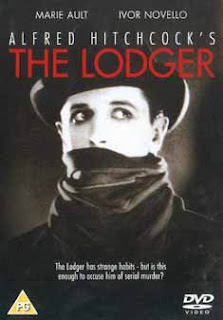 ,
,
this makes the audience try to figure what is happening in the narrative rather than having the whole story handed to them through dialogue.
6. )What have you learnt about technologies from the process of constructing this product?
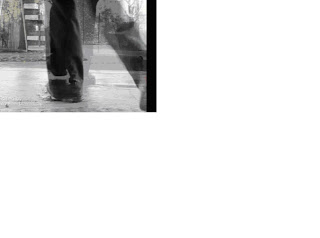
I have gotten better at that from practice and learning from my group. It was difficult for me to use a Mac as it was my first time using it, but soon have come to grip with its programmes like IMovie. IMovie was complicated at first but gotten easier to use for my film, which helped me to edit and uploaded the footage we have filmed as a group onto IMovie.
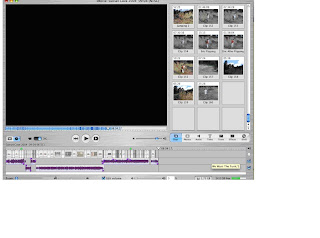
Another aspect of the technological process we were meant to use was our blogger on the webpage which at first I found hard to keep updating and continue uploading but gotten used to the idea of conveying to our teachers what I was up to and my where about in our project. Overall all of the things I had to learn and practice on allowed me and my group to produce our media quality to the best of our ability.
7. )Looking back at your preliminary task, what do you feel you have learnt in the progression from it to the full product?
Thursday, 30 April 2009
Jermaine's Evaluation


Monday, 27 April 2009
Music
Evaluation: Georgia Perkin
We named our film ‘Til Death Do Us Part’. We chose this title as we thought it was a hint of the plot, and it creates a mysterious yet threatening atmosphere which is what we had planned. A member of our group (Jermaine) designed and made the music for our media. We were very happy with this because this music added to the suspense and mystery that the title suggests. The slow, gloomy sounding piano creates this mystery. We were trying to create the effect of a flashback as this showed a change of thought and time. We also used black and white in the flashbacks to differentiate between the past and the present. When watching Memento, which also used this effect, we noticed that they subverted the conventional use of black and white, which had an effect on the way the audience viewed the film. When preparing to begin this project we watched ‘The Birds’ – Alfred Hitchcock. In this thriller he took an every-day, ordinary setting and subverted this by the strange, extra-ordinary events that then started happening. This idea influenced us greatly when we thought about the mise-en-scene, as the image of an ordinary domestic setting was destroyed as soon as the male character was introduced, as we introduced him to be untrustworthy and creepy; see screen-shot below for an example (Even though later on in the narrative he turns out to be the victim. This is not evident in the opening!). We established this by the mise-en-scene; nothing in the background seemed abnormal in any way, they were just every day objects creating an ordinary home.
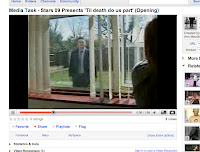
We kept the lighting in all scenes to the natural light when filming to emphasise that wanted sense of normality in our protagonist’s life. We were aiming to subvert the conventional dangerous man vs. innocent/victimised woman in the narrative (for example; image below), though this wasn’t made entirely evident in the opening as it would have defeated the point of the non-linear narrative.
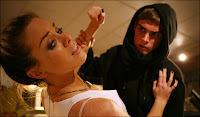
2. How does your media product represent particular social groups?
In Western culture, women are often viewed as emotional and irrational as opposed to men who are seen as reasonable, hence their right to operate in the public world, where women are confined to the private, domestic sphere. It could then be argued that we have adopted this Western view, by having our villain a woman. We chose to adopt this view as we wanted to challenge the often used stereotypical male villain, female victim. Our target audience would want to watch something that's a little different to a lot of thrillers in the box office, so would therefore be more attracted to our movie as there's a female villain. During the opening, the characters are seen very differently to how they would have been later on in the film.

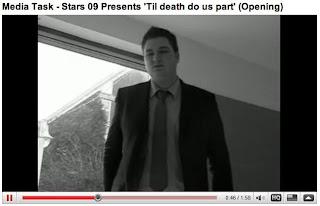 3. What kind of media institution might distribute your media product and why?
3. What kind of media institution might distribute your media product and why?After research, I came to the conclusion that Pathé Distribution would be likely to distribute our film. I originally decided an independent, English company would most likely distribute ‘Til Death Do Us Part’, yet Pathé caught my eye as they have recently distributed one of our main influential films – ‘Memento’, giving me the impression that they may be interested in the type of film that we have started. They have also distributed films like ‘Slumdog Millionaire’ – a film that has had great success through Pathé.
 They distribute for about 20 titles per year, "ranging from quality and specialised films to crowd-pleasing mainstream movies and genre titles" (Pathé website). This would give our film a wide audience which would give the film a larger chance to be introduced to our target audience.
They distribute for about 20 titles per year, "ranging from quality and specialised films to crowd-pleasing mainstream movies and genre titles" (Pathé website). This would give our film a wide audience which would give the film a larger chance to be introduced to our target audience.4. Who would be the audience for your media product?
During the first stages of the project, we decided to design surveys to ask different people to fill in. Personally, most of the people that answered my survey were from years 11, 12 and 13 so we could get our target audience's opinion, yet there are still some surveys filled out by people older than this to see their views also. After carefully looking at our audience research and feedback, we chose to target our film at 15-25 year olds. We didn’t think the film would be appropriate for those younger than fifteen as some parts of the narrative may be disturbing/upsetting for them, and we'd therefore have to change our original story line. ‘Til Death Do Us Part’ is being targeted at both males and females, as psychological thrillers may apply to both. From the survey below, we gathered to make a good opening (opinions of those that took survey) - our opening had to have a complicated, yet interesting story line (question 2 of survey below), yet an opening that doesn't reveal too much about the story line - this needs to be saved for later on in film!
Our audience feedback told us that we needed to create a sense of mystery to draw in the audience as soon as the opening started. We created this sense of mystery immediately by showing the female looking at a photograph, yet half of the photograph is hidden. Later on in the film, the audience would see the rest of this photo but to entice the audience; it’s hidden in the opening, forcing them to carry on watching to see who photo is of.
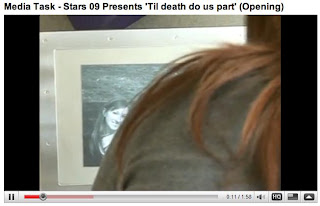
Our use of editing; particularly our use of black-and-white emphasises the mystery in our opening. This use of black-and-white was to show the difference between the normal events and the flashbacks the character is experiencing. This use of editing addresses the audience and makes them want to watch more of the film as they will be more inclined to want to know why the characters having flashbacks and what these flashbacks are actually of (we cut the flashback into two separate sections, disorientating the audience).
When we were first introduced to the project most of my group hadn’t used a Macintosh before, so were struggling with the differences that Macs and PCs have. I was lucky that I have had experience on Macs before, so the change in computers didn’t faze me at all. This project has made me feel a lot more at ease with technology like iMovie for example, though. Previous to A-Level media, I had never used iMovie, I had only used programs such as Windows Movie Maker. As I had only used the Windows movie program and hadn’t used the Mac version, I was slightly sceptical about learning how to use the whole new program. I was introduced to it and shown how to cut and edit things, how to use the timeline and clips pane, and slowly I started to get used to iMovie. Once I’d got used to the sudden chance in software, I decided iMovie was much easier to work with and much more effective than Windows Movie Maker, which I find always crashes! I would have liked iMovie a lot more if it enabled us to layer video, alongside audio. It was helpful that they allow the overlapping of audio, yet we chose not to use this in our film. We did want to overlap video though, where Michael Graham walks past the window whilst the blinds are being shut. We originally wanted Michael to disappear, showing clearly that he’s a ghost, but after trying to create this effect for a while, we decided it didn’t give us the effect we wanted, and it may give too much away in the narrative.
7. Looking back at your preliminary task, what do you feel you have learnt in the progression from it to the full product?
When we made our preliminary task, we were not nearly as organised as we were when making our final product. We didn’t plan time well at all; filming successfully took a lot longer than we had thought it would! None of us had a lot of experience with editing, so we were just getting to grips with iMovie at that time, yet when we were making our final opening iMovie wasn’t new to us so we were able to experiment and feel comfortable with the software. Personally, I’d never done much filming before, and I’d never filmed using a tripod. When filming the preliminary task, I found it hard to keep the camera steady on the tripod, and for the camera to be straight and well balanced. By the time the final film was being made, I was very confident in my use of the camera and was able to focus more on zooms and the composition of the shot as I wasn’t worrying about whether I had put the camera on the tripod properly! In our preliminary task, we had a big problem as one of our actors came to film with a different outfit on. None of us had previously thought about this, and as imagined it was a big problem. As it wasn’t possible for the actress to look the same as she had on the first day of filming, we had to start our preliminary task from scratch, leaving us not much time to film it at all. This was a big lesson for us, as it made us incredibly fussy about if something were to change through days of filming!
Friday, 24 April 2009
Kris-Ann's Evaluation
- Title- Our title was ‘Til Death Do Us Part.’ I thought that this used media conventions, as it was able to suggest the plot of the story without giving too much away. We used this title, as it is a wedding vow so it helped to imply the relationship between our two characters. In contrast I thought our title challenged the media convention of having ambiguous titles, as it had a symbolic hidden meaning rather than being just a title, for example ‘The Uninvited’ shows only a suggestion of an unwanted guest, yet that is the only interpretation we may accumulate, yet our title suggests, perhaps a death, a commitment of some sort, companionship and a relationship.
- Representation- Like horror films we used black and white to represent either a flash back or previous events. for example when the couple argued. We thought that this would also help to explain the history between the two characters. unlike Momento our flash backs were clear of wat time period was being portrayed. due to this factor we were able to to cross dissolve one charter walking in the present to the other walking in the past.
- Music- our music was actually produced by one of the members of our group. We chose his piece of music as we felt it was able to set the mood and atmosphere of our opening.
.How does your media product represent particular social groups?
What kind of media institution might distribute your media product and why?
i chose Optimum releasing as they are a successful British indepent film distributer. i chose them because they specify in the genre of our given task, with the success of their 2008 movie Eden Lake, they would be able to bring high demand to our film. due to contreversay that circulates around there films we thought that our film would get the same recogniton as like Optimum Releasing, you do not know what to expect from our movie. other releases from this company are
Kisses
Who would be the audience for your media product?
By doing questionnaires, we decided that our audience would be aged 15+, we chose this a ge as they were more likely to go to the cinema, therefore, they would be more able to give fresh opinions on what they do/don't like to see in movie. we thought that this wou
ld be a suitable age because our openinig is simplistic but able to keep the audience interested. we also chose this age as some of the content may not be suitable for anyone under that age, due to scenes of violence.
How did you attract/address your auience
when we first made our film we thought of only ideas that would make it a normal conventional thriller opening, but then we got our research which showed us that the audience were bored of typical thriller movies as they already knew what to expect from them. so we decided to make it a romantic thriller with a twist. we thought this would be unexpected as they would probably just be expecting an action packed thriller. we thought this way we would be able to expand our audiences by expanding our selected genre. we decided to contrast the images in our movie, that way the audience could decide what they thought was happening. like Alfred Hithcock, we used the music to sugdest the plot, rather than dialouge as we wanted to address the active audience.
What have you learnt about technologies from the process of constructing this product?
by constructing our film, i have learnt more about the practical approach to editing, i learnt about what scenes would be best fit with others. as i was in charge of editing, i was able to learn more about continuity editing and the problems that may be faced. for example, wen adding the
credits to our film. i first tried fading as i thought this would be effective, but then i realised that by doing this, the credits would be carried to the following sequence which was not helpful, so i decided that it would be best to cross dissolve between the two sections as this way it would get rid of those credits. i also learned how to use imovie on a Mac, this included, 'splitting videos at playhead,' editing, adding effects like black and white to scenes, adding credits to our movie, and the hardest of all, adding the music to our sequence.
Looking back at your preliminary task, what do you feel you have learnt in the progression from it to the full product?
We have have a long way from our prelimanry task as we learnt more about time, by this i meant thot making a movie is not as easy as it looked. due to this we were able to make a timetable of who would be doing different jobs at different times. we also learnt how to use diffeent settings on the camera, for example, when we did our prelimenary task we did not know that there was a light filter on the camera. we learnt more about team work and how easy it was to get things complited if everyone shared jobs. we learnt more about editing and found it a lot easier to bring continutiy to our film.
Wednesday, 18 March 2009
Story Board. FINALLY!!!!







